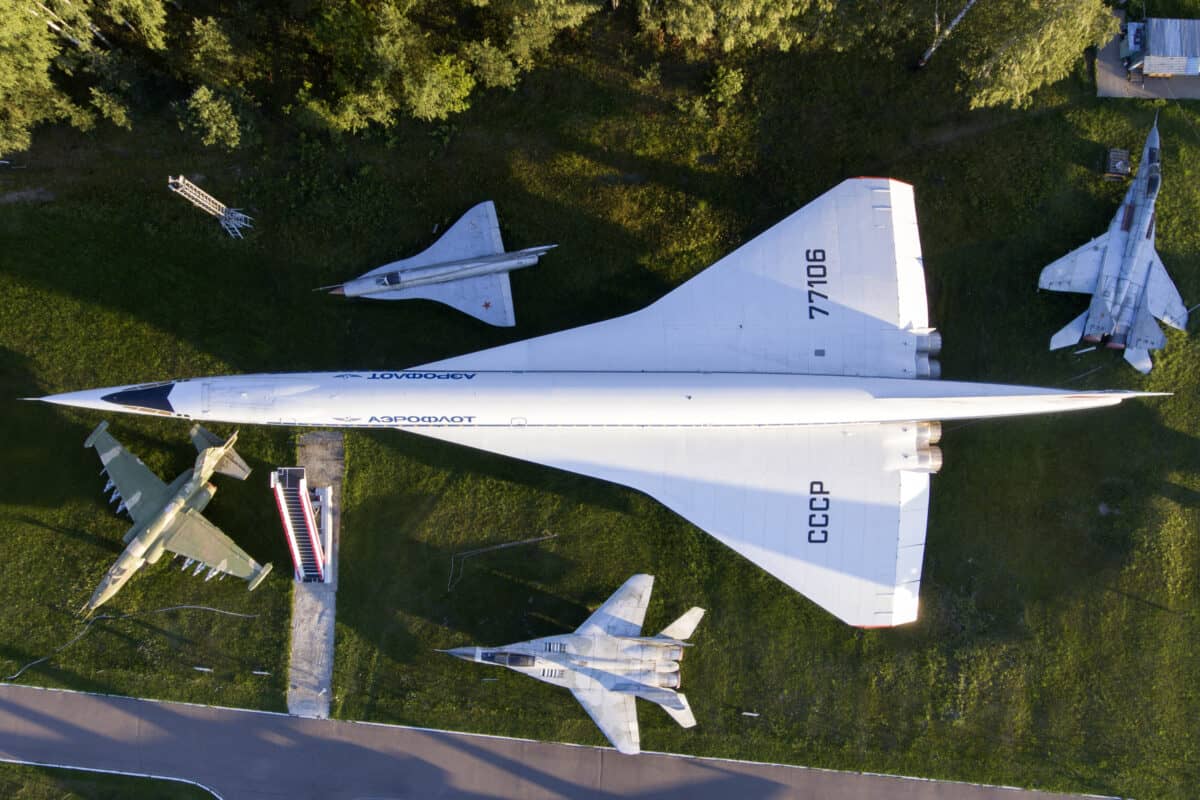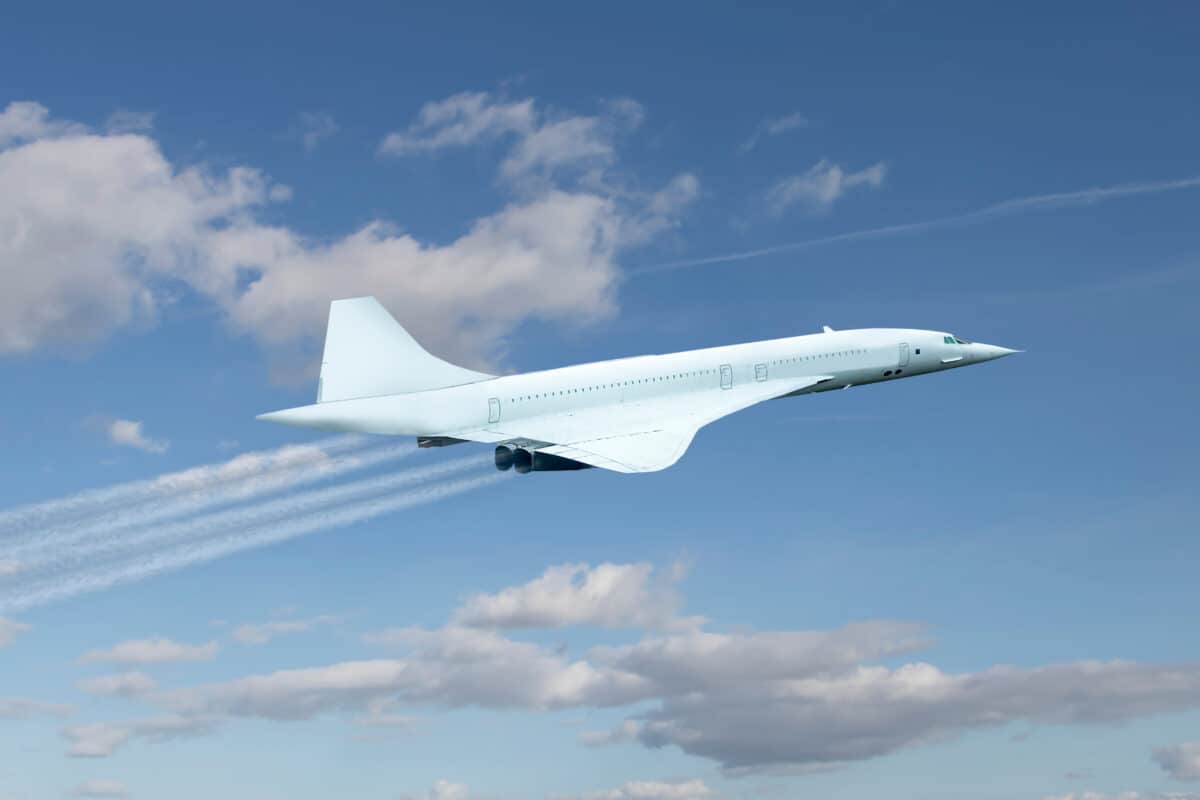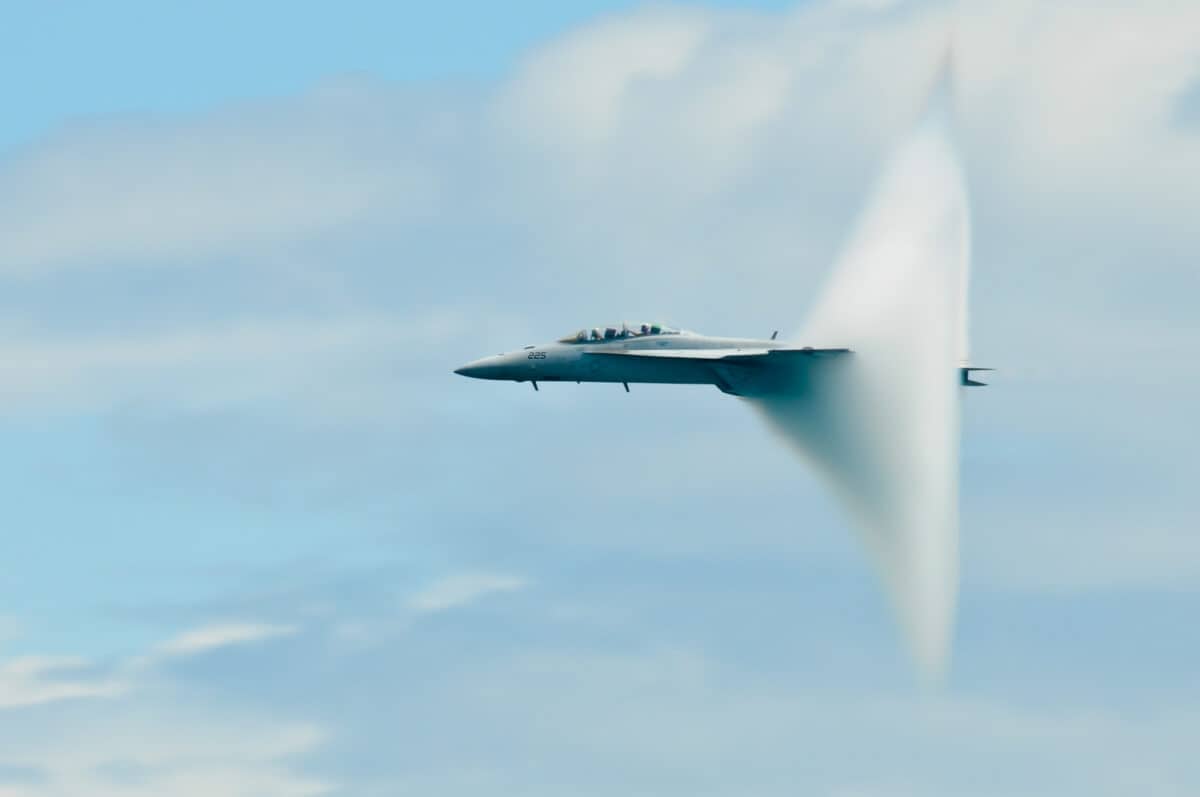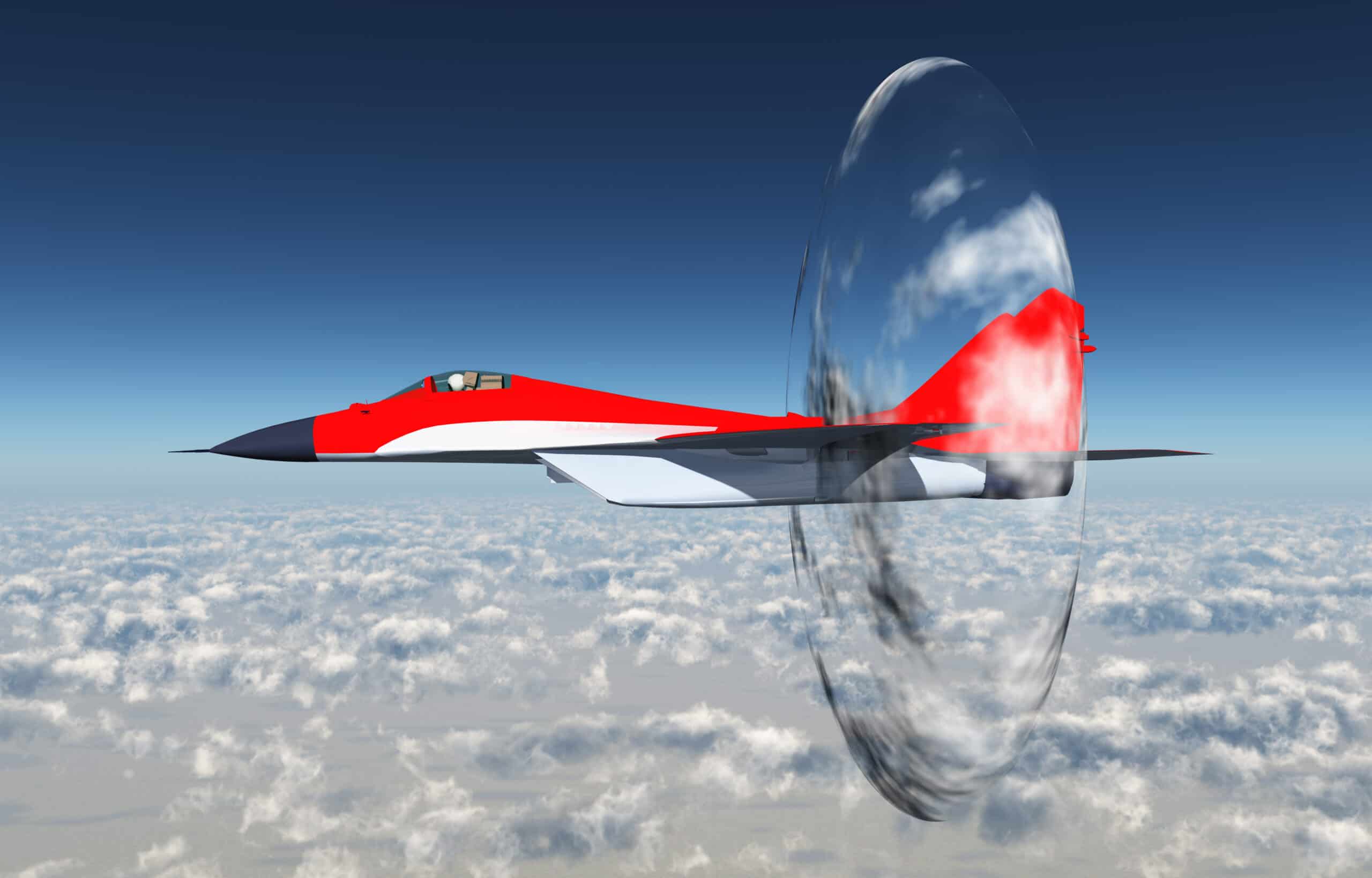Supersonic flight halves flying time, so why do many countries ban it? Learn the truths about shockwaves, sonic booms, and the future of swift flight.
Supersonic aircraft create a sonic boom greater than 100 decibels during flight. People on the ground hear the noise as a loud crack of thunder. The shockwaves have even broken windows in the buildings that the planes fly over.
As a result, in 1973, the Federal Aviation Administration banned commercial supersonic flight over land. Some people say politics and big business caused the demise of supersonic Concordes. But why is supersonic flight banned, actually?
Supersonic Flight History
Military supersonic flights came first and still have permission for overland travel.
Bell X-1

©crbellette/Shutterstock.com
U.S. Air Force Major Charles E. Yeager flew the first aircraft at supersonic speeds. On October 14, 1947, the Bell X-1 dropped from a Boeing B-29 and broke the sound barrier. It reached and attained a top speed of 700 miles per hour (1,126 km/hour), or Mach 1.06. Other military aircraft subsequently flew at sound-barrier-breaking speeds up to Mach 2.5.
Tupolev Tu-144

©Fasttailwind/Shutterstock.com
The Soviet Tupolev Tu-144 was a freight hauler, or supersonic transport (SST), initially intended for passengers. June 1969 saw its first supersonic flight before it began regularly flying mail between Moscow and Siberia in the ‘70s.
Unfortunately, a Tupolev crashed at a 1973 Paris Airshow, signaling the beginning of its end after another Tu-144 carrying passengers went down in 1978.
Concorde

©agsaz/Shutterstock.com
The supersonic French/ British Concorde planes carried a hundred passengers and crossed the Atlantic at Mach 2 from 1976 through 2003. It even made the trip from New York to London in under three hours.
Round-trip tickets cost nearly a whopping $10,000 each, finally allowing British Airways to clear a profit after years of government subsidies. The planes symbolized wealth and speed, whose design and manufacture came at British and French taxpayer costs.
People living in the Concorde’s flight paths complained about the enormous noise. Then, in July 2000, an Air France jet crashed after takeoff, tragically killing all 109 souls aboard. After that, it took a year before any Concorde gained clearance and flew again.
Concorde Controversy
The overall operating costs and surrounding problems proved too high. Amidst some controversy, Airbus forced Concorde into retirement in 2003 by pulling their Type and Airworthiness Certificates. Since British Airlines was finally profiting and had recently refurbished and upgraded five of its planes, they hoped to continue transporting passengers.
However, Airbus refused to allow continued operation. Some people believe the Concorde’s permanent landing came from Airbus struggling to sell its A380 and A350 planes.
- Concorde served senior business people.
- The Concorde crossed the Atlantic in half the time of regular jets.
- Concorde’s high ticket prices stayed within 10-15% of First Class prices.
- Saving flight time and jet lag for executives easily made up for the extra Concorde ticket price.
- Time is money.
The controversy says that as long as businesses continued flying their executives on Concordes, Airbus struggled to sell other new planes. High operating costs and noise, mixed with business politics after the French crash, all contributed to the reason why this supersonic flight was banned.
Sonic Boom’s Explosive Power

©Katerina_S/Shutterstock.com
Besides the high engineering and manufacturing costs, supersonic flights create explosive sonic booms. The Concorde was a relatively small business jet that still caused ground damage. It had no boom-alleviating technology, so it was not only obnoxiously loud but also broke windows in buildings and homes.
Subsonic flight speeds allow the plane to push the air in front of it out of the way. Supersonic speeds, meaning when an aircraft travels faster than the speed of sound, have very different results. Instead of pushing the air ahead out of the way, it remains still until the plane comes within a half inch of it.
Then the air gets explosively forced aside within a few millionths of a second. Extreme heating and compression force a shockwave up to 30 miles outward with enough vibration to damage ground structures.
Shock Wave Explained
An easy way to understand shockwaves is to think of the process visually. It is hard to imagine air pressing around and then breaking. Instead, think about how boats travel through water and push it forward.
The water moves away from the boat’s bow and spreads across the lake. You might hear it called the “wake” or “wavefront.” This visible bow-wave of water moving across the lake resembles the sonic boom from an airplane disrupting air in its path.
The shock wave, or sonic boom, comes from the sharp pressure change within a narrow region when a plane travels through air at speeds faster than sound.
Why Is Supersonic Flight Banned, Actually?
The sonic boom ban came after Americans filed tens of thousands of claims against the Air Force supersonic jets during the 1950s and 1960s. Then, the Federal Aviation Administration (FAA) prohibited overland supersonic commercial flights in 1973. The law, FAR 91.817, is still in effect to limit sonic booms.
Legislation
The United States isn’t the only country with a sonic boom prohibition. A British activist, Richard Wiggs, started the Anti-Concorde Project in 1966 to challenge all supersonic transport aircraft. He used full-page newspaper ads to claim that the planes affected ozone layers, in addition to their noise pollution.
By the time Concordes were ready to fly, Wiggs and his project had already convinced many listeners only to fly them over water, not land.
For instance, the Port Authority for New York and New Jersey temporarily banned the Concorde in 1976 from JFK Airport landings due to protests against the noise. Some 2,000 cars stopped traffic near the airport in opposition to the sonic boom explosions.
Other countries also have legislation against sonic boom noise.
- Canada only allows supersonic flight over low-population areas.
- Malaysia residents and lawmakers opposed the Concorde flight to neighboring Singapore, forcing a stoppage after three flights.
- The International Civil Aviation Organization prohibits sonic booms from reaching the ground surface.
Future Plans for Supersonic Flight
With the promise of commercial supersonic flights returning as early as 2029, travelers look forward to reduced flight time and more accessible world travel.
NASA/Lockheed Martin Quesst
NASA’s Quesst mission aims to design and build the X-59 research aircraft in conjunction with Lockheed Martin in Palmdale, California. Quesst stands for Quiet SuperSonic Technology.
The group of engineers and researchers use advanced technology to reduce a sonic boom’s alarming loudness to a gentle thumping sound for people on the ground. After completing the build, NASA will fly the aircraft over U.S. communities and gather human response data to the supersonic flight sounds.
The mission plans to present data to U.S. and international regulators in 2027 with the goal of new sound-based rule generation for overland supersonic flights.
The goal is to allow aircraft manufacturers to use sonic-boom suppression technology on future commercial supersonic planes. Then, you’ll be able to fly from Los Angeles to New York by lunchtime.
Here are some of the project’s significant timelines:
- Phase 1: Aircraft Development 2018–2024,
- Phase 2: Acoustic Validation 2024,
- Phase 3: Community Response Study 2025-2026,
- Final data to regulators 2027.
American Airlines/Boom Supersonic
While NASA and Lockheed Martin builds and tests the X-59, companies like American Boom Supersonic and Spain’s Oscar Viñals race to make commercial supersonic flight possible by 2029. That means you could fly from New York to London in 3.5 hours instead of the usual 7.
Boom bills its supersonic plane, Overture, as “the world’s fastest airliner — optimized for speed, safety, and sustainability.” The plane’s sleek look comes from a contoured fuselage that optimizes airflow, resulting in higher fuel efficiency and reduced drag.
The company says, “productivity meets tranquility,” and this plane is a thing of beauty. From its sleek contours to the proposed seating arrangements, it exudes the future of air travel.
The image featured at the top of this post is ©Michael Rosskothen/Shutterstock.com.







